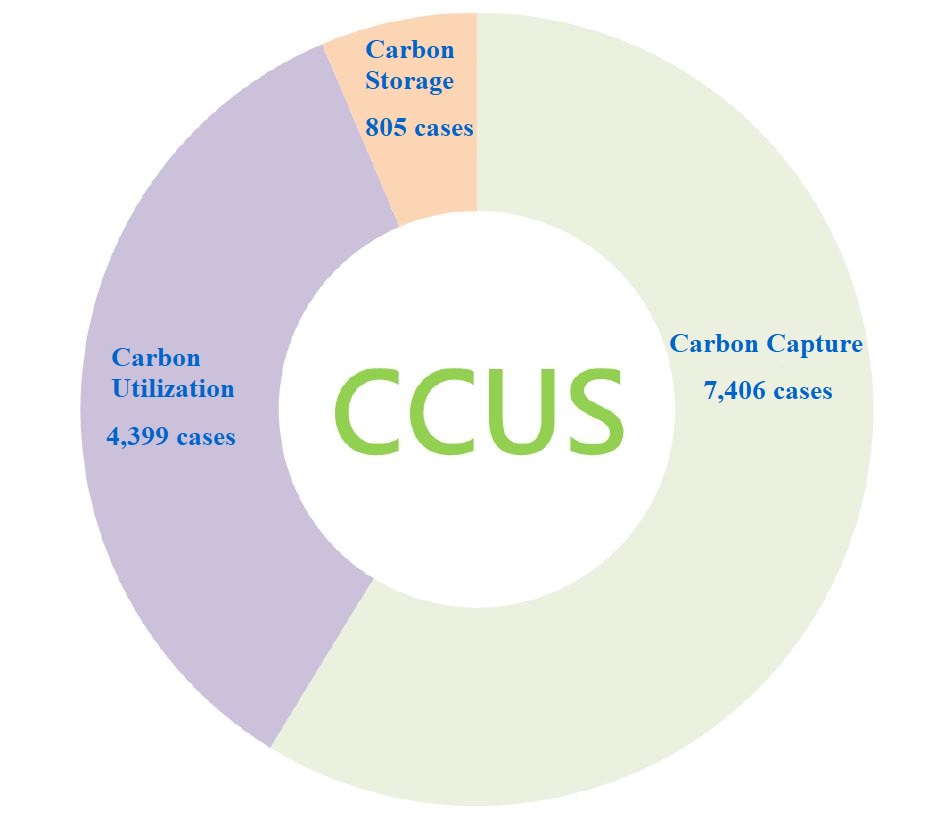CCUS in 2050 Net Zero Transitions – An Opportunity for Business Growth

Renewable energy plays a critical role in achieving carbon neutrality, and carbon capture, utilization, and storage (CCUS) is considered the final stretch towards net zero emissions. TIPO has compiled an analysis report on CCUS patent application trends and an overview of the patent landscape in this field for public reference.
TIPO reports 12,610 global CCUS-related patent technologies (patent families), with 7,406 families in carbon capture, 4,399 in carbon utilization, and 805 in carbon storage – numbers continuously growing as the importance placed on addressing climate change increases. The Office’s analysis of the global patent landscape revealed a correlation between market sizes, level of importance placed on related issues, and number of patent applications. China, Europe, and the United States now have the record for the highest number of applications, most of them being local applications.
Carbon absorption is the most prevalent and advanced technology among carbon capture methods, accounting for 39.1% of all related applications. Said method involves capturing carbon dioxide emissions using an absorbent. Adsorption technology, which accounts for 26.7%, is the next most prevalent, utilizing an adsorbent to bind carbon dioxide. Membrane separation technology, accounting for 12.5%, employs a thin film of organic or inorganic material to separate carbon dioxide from other gases. Although absorption technology continues to lead the field, there is an increasing trend in patent applications for adsorption and membrane separation, indicating that various companies and organizations worldwide are exploring a diverse range of carbon capture technologies.
TIPO’s report highlights that despite the limited presence of patent applications for carbon capture technology in Taiwan, certain companies and research institutions are actively pursuing research and patenting said technologies. As an example, the Industrial Technology Research Institute and Taiwan Cement Corporation are collaborating to capture carbon dioxide through calcium looping process in order to reduce energy consumption and additional carbon dioxide emissions in the cement production process, demonstrating a leadership role in carbon capture technology.
Carbon utilization technology has a broad range of applications, including the conversion of carbon dioxide into chemicals like methanol and methane, and even into novel carbon-based materials such as graphene, carbon tubes, and carbon fibers. Of the various methods for reusing carbon dioxide, the numbers of patent applications for converting carbon dioxide into methanol (11.4%) and methane (8.3%) are relatively high. Major companies, including CPC Corporation and Formosa Plastics Corporation, are investing in such technologies to boost competitiveness in the petrochemical industry. The China Steel Corporation has also leveraged its close proximity to local petrochemical companies and formed partnerships in steel and chemical co-production to optimize carbon capture and utilization/usage (CCU) benefits. Furthermore, with limited R&D in the field of novel carbon materials and a majority of investors being start-up companies, converting carbon dioxide into novel carbon materials could be a potential new business opportunity for SMEs in Taiwan.
Applications for carbon storage technologies primarily come from countries or companies that possess oil and gas resources, with 48.1% of the applications focused on the technology of underground injection of carbon dioxide into reservoirs during oil and gas extraction. The implementation of carbon storage technology is limited in Taiwan due to the absence of natural gas or oil production, regulatory hurdles, and the requirement to gain consent from nearby residents for underground injections of carbon dioxide.
As of recent, carbon pricing has been skyrocketing, and regulations are becoming increasingly stringent as countries move toward a consensus on reducing carbon emissions. TIPO emphasizes that industries should stay informed about the global CCUS patent landscape and proactively leverage their strengths and resources to research and develop new technologies so as to seize business opportunities in sustainability, leading to a positive impact on both the environment and the economy in the transition to a zero-carbon economy.
For related information, please see:
https://www.tipo.gov.tw/tw/cp-85-916712-4b1c5-1.html
- Publish Date : 2023-02-08
- Update : 2023-03-08
- Organization : International Legal Affairs Office
- Visitors : 1897

 Sitemap
Sitemap FAQs
FAQs Feedback
Feedback Bilingual Glossary
Bilingual Glossary